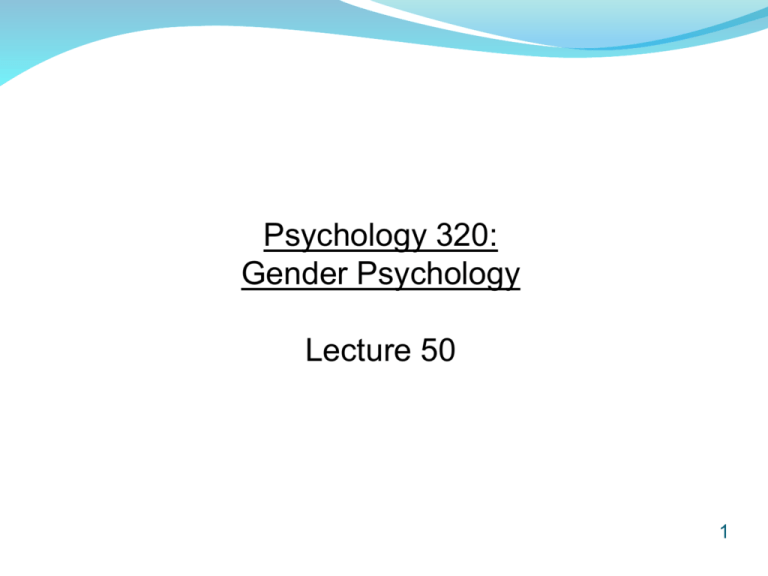
Psychology 320:
Gender Psychology
Lecture 50
1
Invitational Office Hour Invitations,
by Student Number for for Wednesday, March 2nd
11:30-12:30, 3:30-4:30 Kenny 2517
10104073
13945084
60659083
61440087
74222068
2
Achievement:
1. Do males and females make different attributions for
success and failure?
3
By the end of today’s class, you should be able to:
1. distinguish between “optimistic” and “pessimistic”
attributional styles.
2. discuss sex differences in attributional styles.
4
Do males and females make different attributions for
success and failure?
• Attributions for success and failure vary along three
dimensions: Internality (internal vs. external cause),
stability (stable vs. unstable cause), and globality
(global vs. specific cause; Abramson, 1989; Weiner et
al., 1971).
5
Examples: I failed the psychology exam because …
Internal, stable, global attribution: “I’m not very smart.”
Internal, stable, specific attribution: “I’m not good at psychology.”
Internal, unstable, specific attribution: “I didn’t study enough for the
exam.”
External, stable, global attribution: “The grading system at UBC is
not fair.”
External, stable, specific attribution: “The professor doesn’t like me.”
External, unstable, specific attribution: “The exam was too hard.”
6
• A substantial body of research has examined sex
differences in attributional styles:
7
Dickhauser and Meyer, 2006
Among 8-9 year old girls and boys with comparable
grades in math, found that:
(a) girls were less likely than boys to attribute
success to ability (i.e., an internal, stable,
global attribution).
(b) girls were more likely than boys to attribute
failure to lack of ability (i.e., an internal, stable,
global attribution).
8
(c) this pattern of sex differences was strongest
among the top math students in the sample.
(d) teachers were more likely to attribute success to
ability among boys and failure to lack of ability
among girls.
(e) girls attributions were based on their teacher’s
attributions; boys attributions were based on
their teacher’s attributions and on their objective
math performance.
9
Campbell and Henry, 1999
Among college students enrolled in a “management”
course, found that:
(a) males were more likely than females to attribute
their success to ability (i.e., an internal, stable,
global attribution).
(b) females were more likely than males to attribute
their success to effort (i.e., an internal, unstable,
specific attribution).
10
Rosenthal, 1995
Among managers at a financial services firm, civil
engineering company, and local health authority,
found that:
(a) males were more likely than females to attribute
their success to ability (i.e., an internal, stable,
global attribution).
(b) females were more likely than males to attribute
their success to effort (i.e., an internal, unstable,
specific attribution).
11
(c) females were more likely than males to
attribute the success of their subordinates to
ability; males were more likely than females to
attribute the success of their subordinates to
effort.
(d) females (but not males) believed ability had
significantly more to do with the success of their
subordinates than it had to do with their own
success.
12
Mezulis et al., 2004
Conducted a meta-analysis of 266 papers published
between 1994-2001. The papers reported 523
effect sizes, obtained from research involving
41,438 participants. Examined the influence of sex
and age on the attributions. Found that:
13
(a) among young children and early adolescents,
there was no sex difference in attributional style.
(b) among older adolescents and adults, males
were more likely than females to display an
optimistic attributional style.
(c) changes in attributional style across the lifespan
reflected variations in females’ attributional
tendencies rather than males’ attributional
tendencies.
14
Achievement:
1. Do males and females make different attributions for
success and failure?
15






